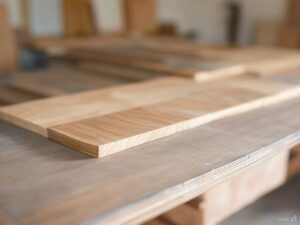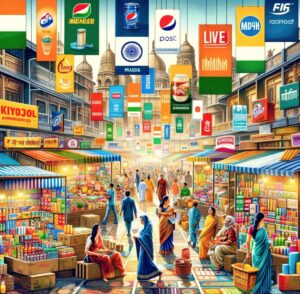1. Greenpanel Industries
Business Model & Segments:
Greenpanel Industries primarily operates in two segments: MDF (Medium Density Fiberboard) and plywood. The company is one of the largest producers of MDF in India, with a growing market share. It manufactures eco-friendly and sustainable wood-based products used in furniture, interiors, and construction.
- Key Products: MDF, plywood, and decorative surfaces.
- Target Market: Furniture manufacturers, interior designers, construction companies, and retail consumers.
Financials (FY 2023):
- Revenue: ₹2,255 crore
- Operating Profit (EBITDA): ₹497 crore
- Net Profit: ₹232 crore
- EPS (Earnings per Share): ₹6.95
- Market Cap: ₹6,532 crore
- P/E Ratio: 28.15
- Return on Equity (ROE): 13.1%
Strengths:
- Market Leadership in MDF: Greenpanel leads the Indian MDF market, benefiting from the growing demand for eco-friendly products.
- Sustainability Focus: The company emphasizes sustainable sourcing and green technologies, which helps it attract environmentally conscious customers.
- Strong Manufacturing Capabilities: Its large-scale production capacity in MDF helps achieve economies of scale.
Weaknesses:
- Raw Material Price Volatility: Fluctuations in wood and timber prices can impact the cost structure and margins.
- High Competition: Faces intense competition in the plywood and MDF segments, especially from players like Century Plyboards and Greenply.
Future Strategy: Greenpanel aims to expand its production capacity for MDF and plywood, enhance its international presence, and focus on sustainable product offerings.
2. Century Plyboards
Business Model & Segments:
Century Plyboards is a diversified company primarily involved in the manufacturing of plywood, MDF, laminates, and veneers. Century Ply has a robust brand presence in the plywood segment and also offers a range of products catering to the construction and interior sectors.
- Key Products: Plywood, MDF, decorative laminates, veneers.
- Target Market: Builders, interior designers, furniture manufacturers, and retail consumers.
Financials (FY 2023):
- Revenue: ₹3,587 crore
- Operating Profit (EBITDA): ₹872 crore
- Net Profit: ₹459 crore
- EPS (Earnings per Share): ₹7.52
- Market Cap: ₹27,715 crore
- P/E Ratio: 60.58
- Return on Equity (ROE): 16.5%
Strengths:
- Strong Brand Recognition: Century Plyboards is one of the most well-known brands in India’s plywood and laminate markets.
- Diversified Product Portfolio: The company has a well-diversified range of products, which helps reduce risk and tap into different market segments.
- Large Distribution Network: The company’s extensive distribution network across India and international markets enables it to cater to a wide audience.
Weaknesses:
- Price Sensitivity: The plywood and MDF markets are highly competitive, and Century faces margin pressure due to price-sensitive consumer demand.
- Raw Material Dependency: As with Greenpanel, Century is affected by the fluctuations in raw material prices, especially timber.
Future Strategy: Century Plyboards is focusing on expanding its MDF production, improving product quality, and innovating in laminate offerings. It also plans to expand its presence in international markets.
3. Greenply Industries
Business Model & Segments:
Greenply Industries manufactures plywood, MDF, and veneers. It operates mainly in the residential and commercial interior design sectors. Greenply has a strong reputation for quality and offers a range of products that cater to both premium and budget segments.
- Key Products: Plywood, MDF, decorative veneers, and laminates.
- Target Market: Builders, architects, interior designers, and retail customers.
Financials (FY 2023):
- Revenue: ₹2,185 crore
- Operating Profit (EBITDA): ₹455 crore
- Net Profit: ₹171 crore
- EPS (Earnings per Share): ₹4.79
- Market Cap: ₹5,200 crore
- P/E Ratio: 30.4
- Return on Equity (ROE): 11.3%
Strengths:
- Strong Distribution Network: Greenply’s expansive dealer network across India provides it with a significant reach.
- Diverse Product Portfolio: Greenply has a well-diversified portfolio, including premium plywood, MDF, and veneers.
- Focus on Quality: Known for its premium offerings, Greenply maintains strong product quality, enhancing customer loyalty.
Weaknesses:
- High Competition: Greenply faces stiff competition in both the plywood and MDF segments, particularly from Century Plyboards and Greenpanel.
- Vulnerability to Price Fluctuations: The company is vulnerable to fluctuations in raw material prices, affecting profitability.
Future Strategy: Greenply plans to expand its presence in the MDF segment and strengthen its position in international markets. The company is also focusing on introducing innovative products in the plywood and veneer categories.
4. Action TESA
Business Model & Segments:
Action TESA is a leading manufacturer of laminates and MDF. The company specializes in high-pressure laminates (HPL) and wood-based panels, primarily serving the furniture and interior design sectors.
- Key Products: Laminates, MDF, and HPL.
- Target Market: Furniture makers, interior designers, and construction companies.
Financials (FY 2023):
- Revenue: ₹760 crore
- Operating Profit (EBITDA): ₹109 crore
- Net Profit: ₹45 crore
- EPS (Earnings per Share): ₹6.35
- Market Cap: ₹1,348 crore
- P/E Ratio: 29.3
- Return on Equity (ROE): 9.8%
Strengths:
- Strong Niche Market: Action TESA’s laminate and HPL products are highly regarded in the market for their durability and aesthetic appeal.
- Affordable Solutions: The company’s products are competitively priced, making them attractive to cost-conscious buyers.
Weaknesses:
- Limited Brand Recognition: While Action TESA has a good market presence, it does not have the same brand power as larger players like Century Plyboards and Greenply.
- Narrow Product Focus: With a concentration on laminates and MDF, the company faces risks associated with market fluctuations in these categories.
Future Strategy: Action TESA plans to expand its laminate and MDF product lines, improve operational efficiencies, and increase its footprint in international markets.
5. Archidply Industries
Business Model & Segments:
Archidply Industries manufactures plywood, MDF, laminates, and veneers. The company focuses on creating sustainable products while catering to both the residential and commercial sectors.
- Key Products: Plywood, MDF, veneers, and laminates.
- Target Market: Builders, architects, interior designers, and furniture manufacturers.
Financials (FY 2023):
- Revenue: ₹525 crore
- Operating Profit (EBITDA): ₹63 crore
- Net Profit: ₹29 crore
- EPS (Earnings per Share): ₹3.55
- Market Cap: ₹1,206 crore
- P/E Ratio: 25.5
- Return on Equity (ROE): 11.2%
Strengths:
- Sustainability Focus: Archidply focuses on sustainability, which is a growing trend among environmentally conscious consumers.
- Growing Export Presence: The company has started expanding its presence in international markets.
Weaknesses:
- Brand Awareness: Compared to larger competitors, Archidply lacks strong brand recognition in the Indian market.
- Competitive Pressure: Faces intense competition in the plywood and MDF categories, which can squeeze margins.
Future Strategy: Archidply aims to expand production capacity, strengthen its eco-friendly product offerings, and increase its international presence.
6. Kajaria Ceramics
Business Model & Segments:
Kajaria Ceramics is one of India’s leading manufacturers of ceramic tiles. The company’s product offerings include floor tiles, wall tiles, and sanitary ware. Kajaria is known for its premium tiles and has a significant share of the Indian ceramic market.
- Key Products: Floor tiles, wall tiles, sanitaryware.
- Target Market: Builders, architects, interior designers, and retail consumers.
Financials (FY 2023):
- Revenue: ₹5,800 crore
- Operating Profit (EBITDA): ₹1,054 crore
- Net Profit: ₹470 crore
- EPS (Earnings per Share): ₹15.32
- Market Cap: ₹32,100 crore
- P/E Ratio: 62.3
- Return on Equity (ROE): 17.4%
Strengths:
- Market Leader in Ceramics: Kajaria is the market leader in the ceramic tile segment in India.
- Strong Brand Image: The company has a strong brand, offering both premium and affordable options.
- Large Manufacturing Capacity: Kajaria has extensive production facilities, which helps meet the growing demand in India and abroad.
Weaknesses:
- Dependency on Real Estate Market: Kajaria’s performance is tied to the construction and real estate market, which can be cyclical.
- Price Sensitivity: Despite being a leader, the ceramic tile market is highly price-sensitive, which can affect margins.
Future Strategy: Kajaria plans to expand its product offerings, enhance its distribution network, and increase its footprint in the international market, particularly in high-demand regions like the Middle East.
Conclusion:
- Financial Performance: In terms of revenue, Kajaria Ceramics stands out as the largest player, followed by Century Plyboards. However, Greenpanel Industries shows strong profitability in the MDF segment, making it an emerging leader in its niche.
- Market Segments: While Kajaria dominates the ceramics sector, Greenpanel, Century Ply, and Greenply are the leading players in the plywood and MDF markets. Action TESA and Archidply are positioned as niche players with strong offerings in laminates and veneers.
- Growth Potential: Companies like Kajaria and Century Plyboards are likely to maintain leadership positions, but Greenpanel and Greenply are expected to see rapid growth, especially in the MDF space, driven by sustainable products and capacity expansion strategies.




